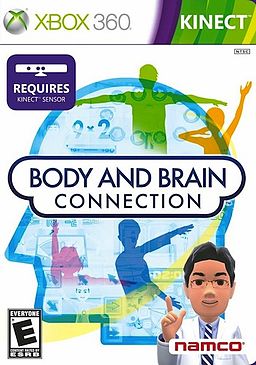- Body and Brain Connection
-
Body and Brain Connection 
Developer(s) Namco Bandai Games Publisher(s) Namco Bandai Games Platform(s) Kinect Release date(s) Genre(s) Computer puzzle game Mode(s) Single player, multiplayer Rating(s) - ESRB: E
Body and Brain Connection, also known as Dr. Kawashima's Body and Brain Exercises in PAL regions, is an entertainment puzzle game developed and published by Namco Bandai Games for the Xbox 360's Kinect platform. It was released in Japan on November 20, 2010, in North America on February 8, 2011, and in Europe on February 11, 2011.
The game features mental problems, such as math questions, in order to keep the user's brain active; in order to answer the questions, the player must perform various physical motions. It received mostly mixed reviews from critics, who felt that the game was mostly harmless.
Gameplay
Body and Brain Connection is a puzzle game which asks mental questions but requires that the answers be performed through physical actions.[1] The game's goal is to reinforce the mental answers by having them be drilled into the player by playing with motion controls.[1] When the player starts the game, it allows the player to take a test which lasts for about ten minutes to determine their "Brain Age", much like the Nintendo DS video game Brain Age does.[1] The player is guided through the brain age tests by Ryuta Kawashima, who also appeared in Brain Age.[1]
Games are usually short exercises that last only for a few minutes. Some of the games include a math game which requires the player to make hand motions in either a "greater than" or "less than" sign and a game which makes the user kick a ball into the goal with the right answer for a math question. Multiplayer is included with the game.[1]
Reception
Body and Brain Connection received mostly mixed reviews from critics, who felt the game was mostly harmless; it received a 57.5% from GameRankings.[2] GameSpot's Chris Watters called the game "shallow and flawed" for its lack of content, but noted that it successfully used Kinect in a "novel way".[3] The Daily Telegraph's Tom Hoggins noted that the game successfully created a new genre called "mathercise", a portmanteau of exercise and mathematics, but felt that the game was weaker than Brain Age because it was attached to a console.[4] The Guardian's Sarah Ditum criticized the game's single player as "slightly sinister" for the mean comments the game makes after bad playthroughs, but praised the game's multiplayer a fun minigame collection.[1] GamePro's Eric Neigher praised the game for bringing something new to the brain-training genre, but criticized the game as not "living up to its potential" and having games to similar to others in the genre.[5]
References
- ^ a b c d e f Ditum, Sarah (February 7, 2011). "Dr Kawashima's Body and Brain Exercises Review". The Guardian. http://www.guardian.co.uk/technology/gamesblog/2011/feb/07/dr-kawashima-body-brain-exercises. Retrieved February 13, 2011.
- ^ "Body and Brain Connection for Xbox 360". GameRankings. http://www.gamerankings.com/xbox360/606350-body-and-brain-connection/index.html. Retrieved February 13, 2011.
- ^ Watters, Chris (February 11, 2011). "Body and Brain Connection Review". GameSpot. http://www.gamespot.com/xbox360/puzzle/brainagekinect/review.html. Retrieved February 13, 2011.
- ^ Hoggins, Tom (February 11, 2011). "Dr Kawashima's Body and Brain Exercises review". The Daily Telegraph. http://www.telegraph.co.uk/technology/video-games/8318611/Dr-Kawashimas-Body-and-Brain-Exercises-review.html. Retrieved February 13, 2011.
- ^ Neigher, Eric (February 8, 2011). "Body and Brain Connection Review". GamePro. http://www.gamepro.com/article/reviews/218135/body-and-brain-connection/. Retrieved February 13, 2011.
- John Powell (April 13, 2011). "'Body and Brain', Kinect software reviews". G4TV Canada. http://www.g4tv.ca/technews/JP/JP_20110413_bodyandbrainbox.shtml. Retrieved April 13, 2011.
Categories:- 2010 video games
- Brain fitness video games
- Kinect games
- Xbox 360 games
- Xbox 360-only games
Wikimedia Foundation. 2010.

